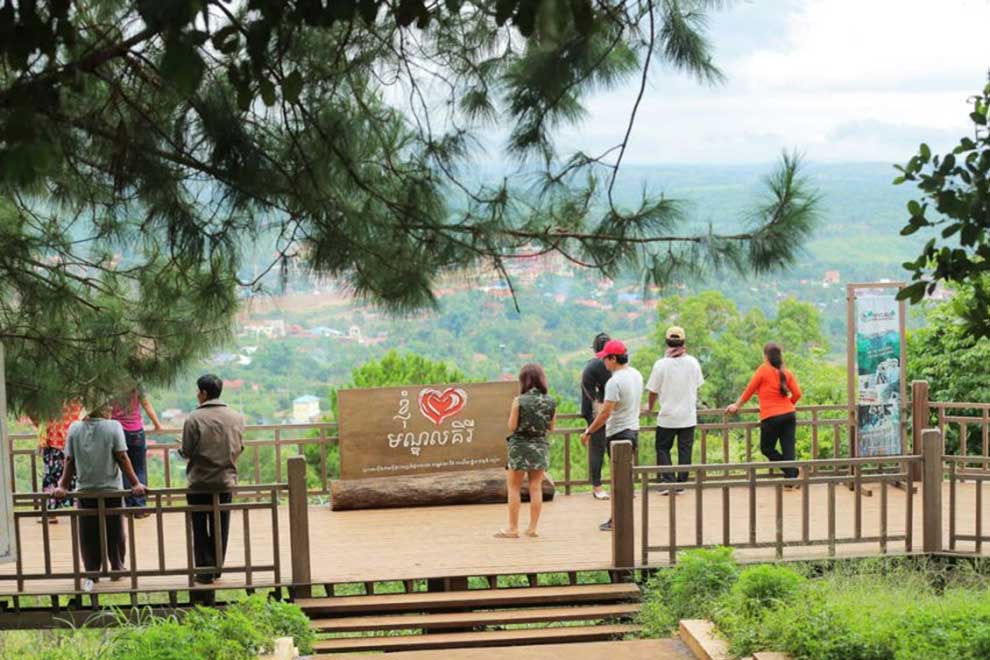
Mondulkiri province expects to receive at least two million national tourists and 900,000 international visitors each year starting in 2035. Hong Menea
Mondulkiri, the Kingdom’s largest province by area often viewed as a backwater bastion of wilderness, expects to receive at least two million national tourists and 900,000 international visitors each year starting in 2035, when a newly-launched transformative tourism development master plan expires.
This was revealed at the official launch of the Mondulkiri Tourism Development Master Plan 2021-2035 on April 11 by Chuk Chumno, director of the Tourism Product Development Department under the Ministry of Tourism.
Chumno said the master plan is designed to turn Mondulkiri into an internationally renown high-tourism area and a major supplier of fruits, vegetables and meats that can not only meet domestic demand but allow for some exports going forward.
“By 2035, international tourists will grow to 900,000, and national visitors to two million; 80,000 jobs will be created, supporting the northeastern region – with Mondulkiri at its core – as the fourth economic pole while striking a balance between conservation and development,” he said.
An initiative of the Ministry of Economy and Finance, the master plan was approved by the Council of Ministers on August 12.
An analysis conducted by a linked technical working group determined that Mondulkiri was full of promise for future development and a whole slew of potentially significant projects that could add value to the tourism industry
and across the spectrum of sectors, and spur economic development in the province and country as a whole, according to Minister of Tourism Thong Khon.
“The master plan aims to provide orientation and development within the strategic framework of Mondulkiri province, based on data and analyses of the actual situation, as well as potential resources for investment and development in the tourism sector and inter-sectoral community now blooming with optimism.
“Sustainable and responsible development in this area is set to bring socio-economic benefits to the people,” he said.
The minister shared that the master plan identifies six key priority areas at the core of its guidelines, designed to shepherd development operations and define the scope of investment.
These are – the natural eco-tourism areas and corridors of the five wildlife sanctuaries; the Bou Sra-Dak Dam Cultural and Ecotourism Corridor; the provincial capital Sen Monorom town; and the area in O’Raing district connected with the development of a widely-anticipated regional-level airport.
The remaining two are – the urban areas of the northern district of Koh Nhek; and the integrated tourism areas along the international border, which touches Vietnam’s Binh Phuong, Dak Nong and Dak Lak provinces.
Speaking at April 11’s event, Aun Pornmoniroth, Deputy Prime Minister, Minister of Economy and Finance and National Tourism Development Committee chairman, hailed the master plan as a “valuable and comprehensive document with a long-term vision”.
Citing the generous amount of domestic trips notched up by Mondulkiri during the Covid-19 crisis, Pornmoniroth maintained that the province’s tourism potential rivals that of more popular travel destinations such as Phnom Penh, and Siem Reap and Preah Sihanouk province.
He said the master plan would integrate Mondulkiri into the Kingdom’s diversification initiatives in agriculture as well as eco, natural and indigenous cultural tourism, and foster development in the northeastern region as the “fourth economic pole” in line with the long-term vision of Prime Minister Hun Sen.
In early February, Prime Minister Hun Sen affirmed his position on establishing Cambodia’s fourth economic pole in the “northeastern region”, with a focus on agro-industry and mineral resources to spur national economic growth. Although the premier did not specifically list the localities considered for the composition of the new economic pole, the northeastern region typically comprises the quartet of Kratie, Stung Treng, Mondulkiri and Ratanakkiri provinces.
Pornmoniroth said that the government has drawn up tourism development master plans for other provinces as well, with a 2020-2035 master plan for Siem Reap rolled out in October, and plans to launch another for Kep for the 2022-2035 period in the pipeline.












